Separation Anxiety In Dogs
Separation anxiety (SA) in dogs is when a dog or puppy panics when left alone. It can be destructive and dangerous, even life-threatening.
Separation anxiety (SA) in dogs is when a dog or puppy panics when left alone. It can be destructive and dangerous, even life-threatening.
Before sharing signs of separation anxiety in dogs and tips to help you address it,
…or more specifically her desire to be outside sunbathing, and not separation anxiety, despite what it may look like in these pictures.

Our first apartment didn’t have a patio or yard, nor did it get a lot of sunlight, so when we moved into this apartment in 2012, Berlin loved sitting outside in the fresh air.
Since we also had a cat, we couldn’t just leave the door open for her to come and go as she pleases, but my desk was nearby and I could easily let her in and out.
Note the screen doesn’t have a grill on it and the glass doesn’t have decorative window clings. These helpful items were only added later after a shocking discovery.
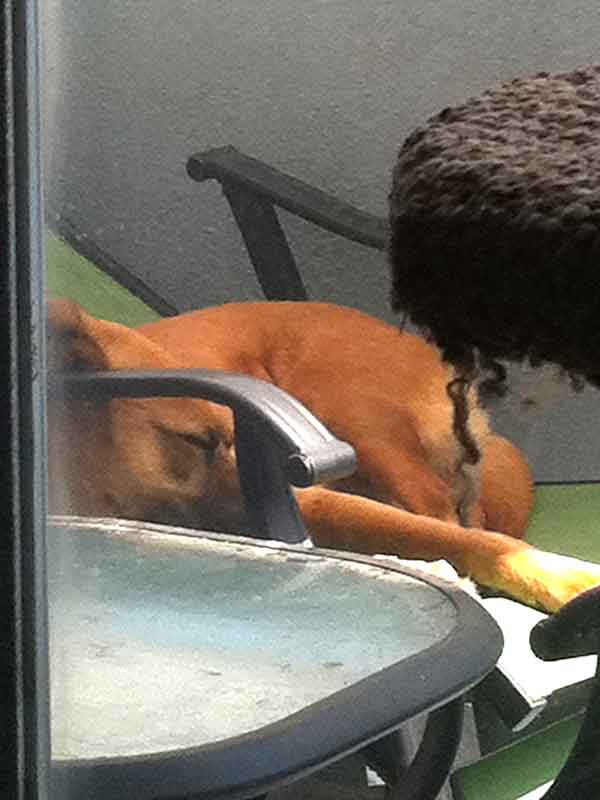
I’m not quite sure how her head stayed propped up, or how she found this comfortable enough to fall asleep, but she did on a daily basis…for hours.
I loved bringing her joy and could watch her all day long.
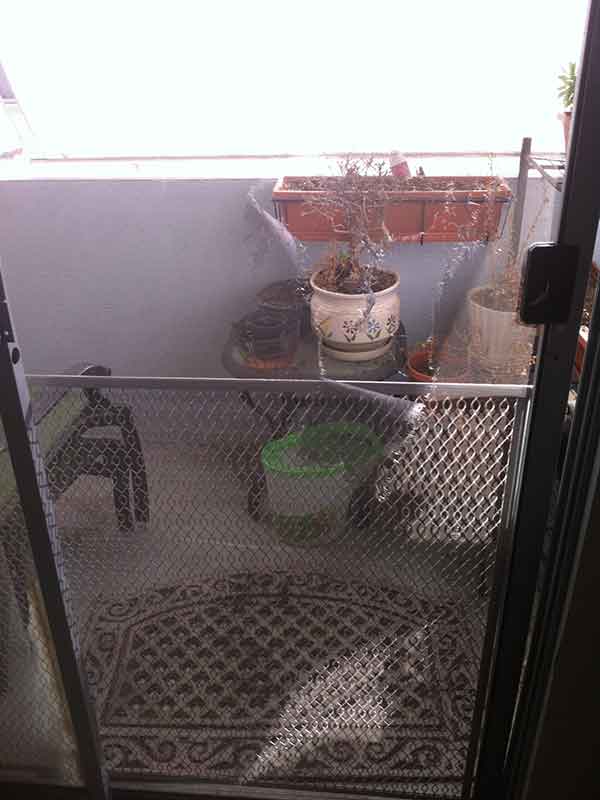
This was probably Berlin’s third offense at breaking onto the patio after we accidentally left the screen door closed but the glass door open when we left. Apparently, the grill we installed on the lower half of the screen was just an invitation to jump over it.
Funny story, the first time Berlin let herself onto the patio I walked in the apartment, saw her peacefully sitting outside, and immediately called my then-boyfriend, now husband. “I cannot believe you left with Berlin out on the patio. She could have hurt herself! Why didn’t you bring her inside?” He said, “I did.” Hmm.
So, I walked over to the screen door and saw this perfect vertical slit. The screen wasn’t pulled back. You actually couldn’t tell at all that it was damaged unless you were looking at it up close.
I opened the screen door and called Berlin inside without punishment.

It was easy to see each day as the sun set that Berlin was scratching at the glass in an attempt to get out while we were gone.
Dogs can and do break through glass doors and windows, but the glass didn’t appear to be at risk of breaking otherwise we would have implemented additional safety measures.

Darn, we forgot to close the glass door again. Berlin was once again fine, and our cat was safely inside (he had no desire to go out, thank goodness!), and to find some humor in the situation I started taking Berlin’s “mugshot”.
Needless to say, I was getting good at replacing screens.
We also started to put decorative window clings on the glass door so we could easily see when we left whether the glass door was closed or not.
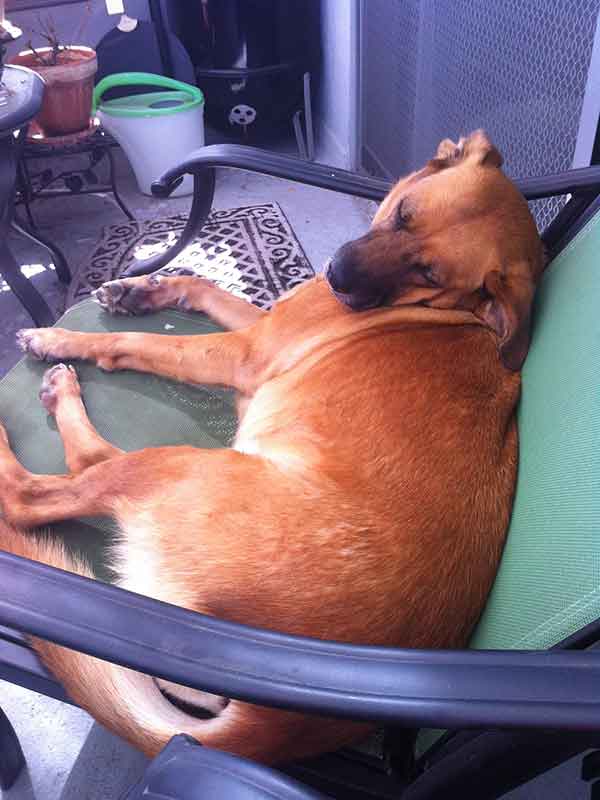
Berlin’s happy place out on the patio, which we still let her out on when we were home. It brought her so much joy.
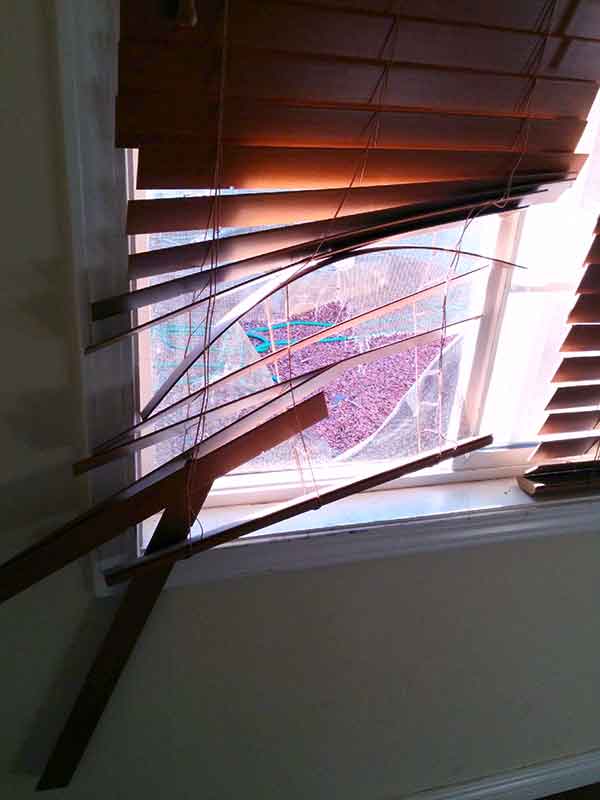
Berlin wasn’t on her best behavior when staying with friends while we were out of town. She “rearranged” their blinds and helped herself outside through their bedroom window, which was luckily very low to the floor on the ground level, all while they were home! What a stinker!
Not only was she not hurt, but she didn’t break any of the slats, so it was an easy fix. Understandably, she wasn’t allowed in their bedroom anymore.
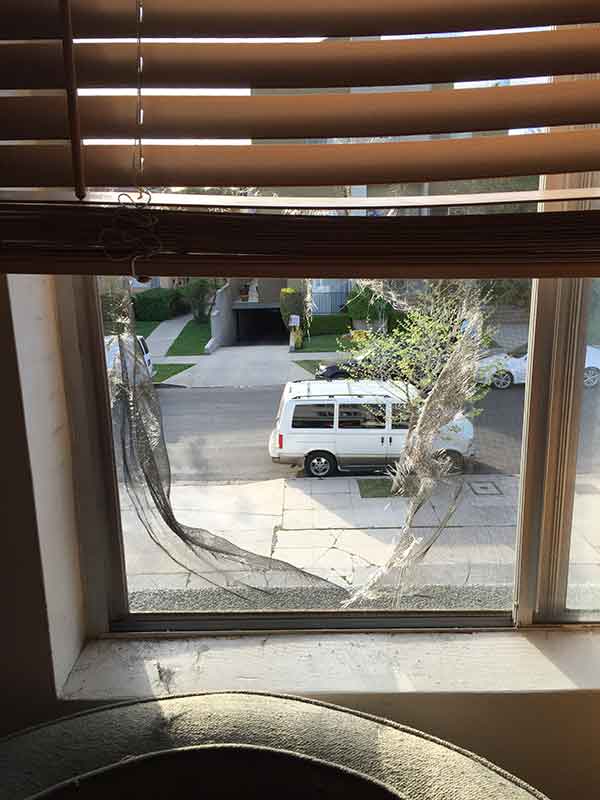
This is the one that terrified me even though I knew Berlin was safely snoring away in the living room when I discovered this exit attempt.
I had just walked by Berlin in the living room when I went to the bedroom to pick out my clothes for an evening out. The blinds were next to the closet and fully closed. It looked as though there were bird feathers coming out between the slats. I lifted them apart and the frayed fabric lead me to discover this large hole in the screen.
I was filled with both shock and gratitude. It was a two-story drop below. Whenever this happened, Berlin clearly could have fit through the opening she made and I don’t even want to think about what next.
Have I also said I’m glad our cat wasn’t inclined to go outside?
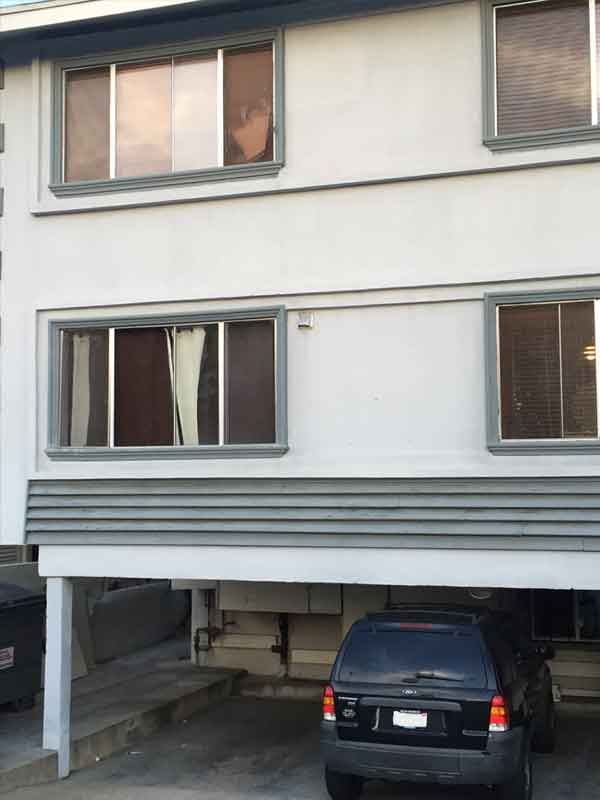
Here is a view of the drop. You can see the damaged screen in the upper left. My heart drops when I look at this photo. I am so lucky.
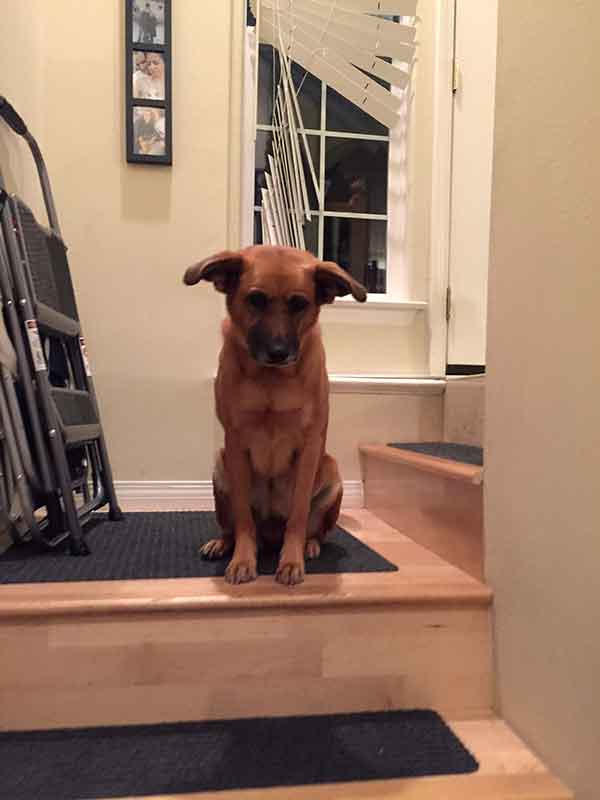
So after we learned all the tricks of the apartment to keep Berlin safe while we weren’t home, we had some hiccups when we moved into our townhome.
We no longer had a sliding glass patio door, though we did have a nice garden-level patio that Berlin could enjoy when we let her out the solid front door (inserted foreshadowing). Originally our plan was to raise the horizontal blinds whenever we left…until we forgot one day.
The new solution was vertical blinds. We never had another problem…with these windows.
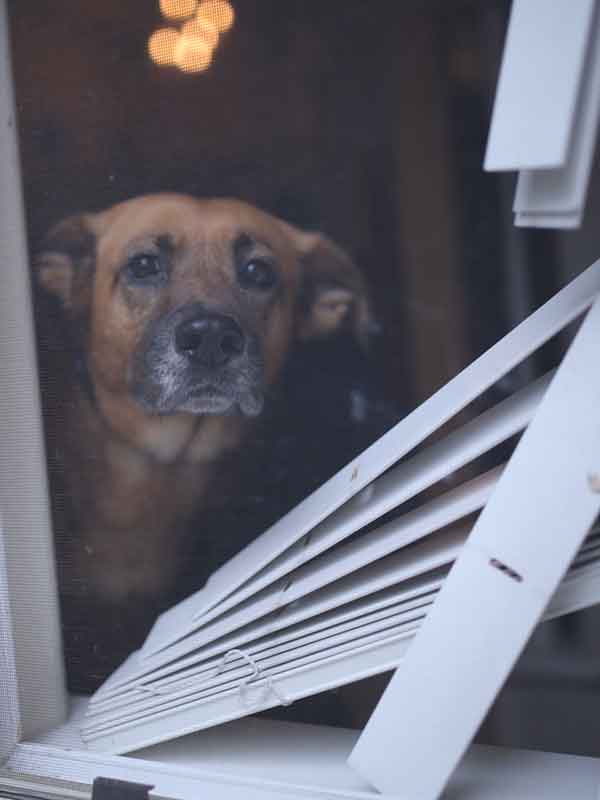
There were some other minor incidents in our new townhouse, mostly when guests didn’t heed our warning and opened their bedroom windows just 1-2 inches.
In this instance, we got back from a walk to find the screen had fallen two stories onto the garden below. Luckily Berlin couldn’t push the window glass over, and even if she could, hopefully, would have made the same decision as in our apartment. We didn’t want to take that chance and allowed our guests to feel completely and utterly guilty.
This is a picture of Berlin after the initial incident in our new townhouse.
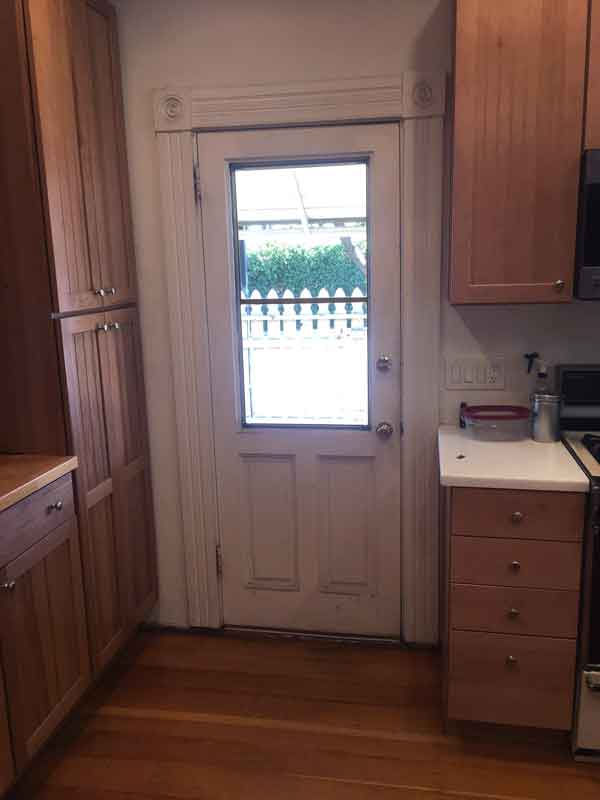
Our doors at home were solid, but another friend who dog-sat Berlin had a window in his back door.
One day while caring for Berlin, he came home from work and was surprised to see Berlin relaxing outside in his fenced backyard, stress-free and basking in the rays. After investigating if he left the door open, he realized he hadn’t and that she had jumped through the door’s window.
I would pay a lot of money to have a video of this accomplishment. Nothing was damaged, she again wasn’t hurt, and was apparently simply seeking a place to sunbathe.
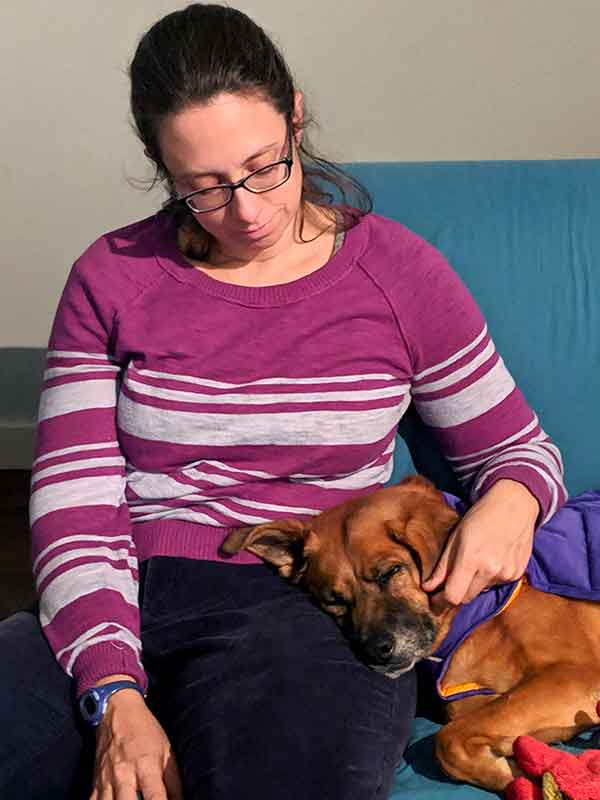
This is the one time Berlin’s destruction was not due to frustration, and I feel bad about it to the day.
It was the first night we arrived for our month in Vancouver where my husband was temporarily working. It was a long road trip for me from SoCal and a long workday for him, so we decided to go out to dinner.
I had brought curtains to hang for privacy while protecting the horizontal blinds but, perhaps because Berlin had spent many evenings in hotel rooms without trouble (this studio apartment wasn’t much different), we mistakenly thought she’d be ok while we were gone this one evening as well.

Alas, we returned and found that she had destroyed all four sets of blinds. I was immediately flooded with guilt. This was different than the other instances. Berlin was panting and distressed on the couch. I immediately went to her to see if she was hurt. Luckily she wasn’t. I held her and decided we needed a walk to get out our anxieties.
The next morning we hung the curtains. During our time together there I also repaired the blinds (props to me for doing so while in a different country!), kept them up, and helped make Berlin feel comfortable in this new, temporary space. We never had another issue, here or anywhere else.
Here is her “mugshot”.

Fixing the blinds with my assistant.
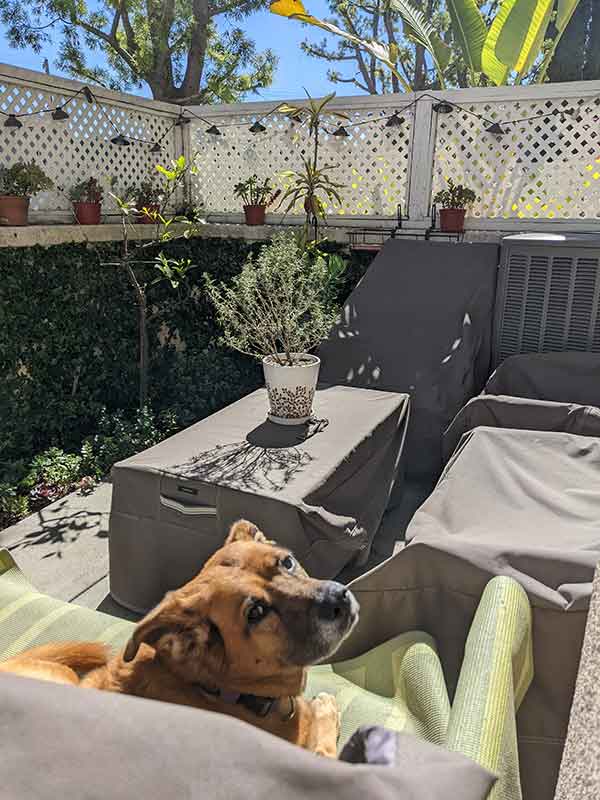
Back at home, Berlin enjoyed many years of “Lunchtime Sunshine” out on the garden patio, never letting herself out or causing any destruction after the incident in Vancouver.

It was apparent she was still thinking about it though, even at the age of 14.
Whining/Pacing As You Prepare To Leave Or After You’ve Left
Constant Barking Or Howling While You’re Gone
Desperate & Often Harmful Attempts To Get Out*
Trembling Or Shaking
House Soiling
Sweaty Paw Pads
Appetite Suppression
Dilated Pupils
Panting and/or Drooling
*Destructive behavior as a result of separation anxiety often occurs near doors and windows.
In other words, not all destructive behavior is related to separation anxiety. It might just be frustration intolerance.
Separation anxiety in dogs is not mere frustration or boredom that you are gone/they are alone or inability to be obedient. Instead, SA is fear-based.
If your dog is just having accidents or chewing/digging in areas other than by doors and windows or barking/whining, they may have frustration intolerance, not SA. Like children, your dog needs to be taught to properly deal with their frustration.
Never correct destruction or accidents after the fact.
Your dog might look guilty when you arrive home, but this is to prevent your wrath, not because they feel bad for tearing your couch to pieces. Instead, the next time you leave they might even be more nervous as they anticipate your angry arrival. Eek!
Make necessary exits and arrivals low-key.
If you make a big deal about coming and going then your dog thinks this is a major event and becomes emotionally overloaded.
Desensitize & counter condition your dog to your exit routine.
Your dog probably knows you’re leaving before you pick up your keys and is already terrified of your imminent departure way before you walk out the door. It’s important to make them feel differently about these signs and signals.
Do not leave your dog alone (until they have been rehabilitated from their separation anxiety).
This will only cause your dog to regress. Bring them to a friend’s place, get a dog-sitter, or take them with you (being careful not to leave them in a car in even moderately warm weather..cars become greenhouses very quickly) or to daycare. Only if absolutely necessary, leave them alone in another part of your home. In other words, divide your home into two areas.
Area #1 Free Run, Counterconditioning Area.
Room(s) your dog gets to be out and living in with you that is away from windows, which can overstimulate them, especially when you are gone. This is the area you’ll use for counterconditioning and where we’ll want your dog to associate feeling good when you leave. Keep in mind that free run of your entire house might be too stimulating for your dog.
Area #2 Must Be Left Alone Area.
In the instance(s) you must leave your dog alone, secure them in a used part of your home that feels like part of the “den” but where they can’t do much damage* and is not used as Area #1. In other words, if you want your dog to eventually have free run of the downstairs, secure/crate them in a bedroom, not in the unused basement where they will be most afraid (because no one ever lives there). Help them feel more comfortable here by sitting on the floor and reading a magazine, scratching their belly and giving them treats and meals in this place.
Remember how I said that separation anxiety in dogs is an emotional response?
To get your dog to like their crate, play the Crate Game. Keep reading.
Does Your Dog Have Separation Anxiety?
If you’re sure your dog has separation anxiety, your responsibility is to teach your dog a new reaction (aka CER or conditioned emotional response) as you are preparing to leave and when you walk out the door.
Will Another Dog Help?
Possibly…but do you (and your current dog) want another dog? Two dogs are often more than double the work of one. Ask yourself, is your dog anxious about being alone or being away from YOU.
Will Punishments And Corrections Help?
If your dog has separation anxiety and they have destroyed (parts of) your house, no, punishment and corrections won’t work and in fact, might make their condition worse.
Take your justified anger out on something it can’t hurt, tell your dog how terrible they are in a sweet voice, and then create a plan to change their emotional response so they no longer feel anxious when left alone.
Provide Appropriate Chew Toys.
Dogs are naturally inclined to chew. so don’t try to prevent it. Instead provide appropriate things for them to chew on like stuffed (frozen) Kongs, Marrow Bones, and Buster Cubes.
More exercise will NOT prevent or cure separation anxiety but it can protect your home from a bored, frustrated dog.
What About Medications?
These may be a good tool, used in conjunction with counterconditioning if your dog’s health is at risk, but they are not a solution or an easy fix.
Talk to your vet about your options that will help decrease your dog’s anxiety rather than sedate them into silent desperation.
All medications have side effects, sometimes serious, so only consider using medications if your dog’s SA is extreme, and continue to focus on counterconditioning.
These signs and tips have been adapted from Patricia McConnell’s I’ll Be Home Soon! How To Prevent And Treat Separation Anxiety (in Dogs)
I’d love to help. Reach out to schedule your complimentary phone consultation so I can learn a bit more about you, your dog, and what they’re demonstrating when left alone.

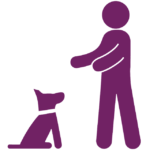

Help Your Dog Lose Weight, Gain Strength, Burn Energy & More

Get out & social with your dog.
All breeds & dog-lovers welcome.



Reach Your Fitness Goals With Convenient, Customized Sessions

Over the next three weeks, you’ll get helpful dog training tips and tutorials, fun canine and human fitness training exercises, and a collection of other healthy living guides right to your inbox 😉.
You’ll also receive additional dog and fitness training pointers, cute and inspirational stories, and my in-person and online class and pack walk schedule through my regular Fun Feet Pawblication©.